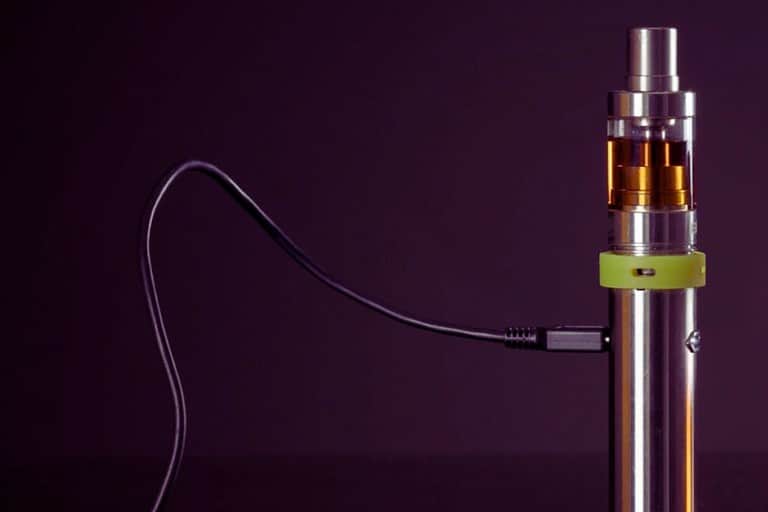Can Metal Detectors Detect Vapes: A Concise Analysis
Metal detectors have become a common tool for security measures, ensuring the safety of various establishments and public venues. These devices are designed to detect metallic objects, such as weapons or other potential threats. However, with the increasing popularity of electronic cigarettes, or vapes, there has been a growing interest in whether or not metal detectors can detect these devices as well. Vapes consist of various components, including a battery, heating element, and metal casing, so it is worth considering the possibility of detection by metal detectors.
The effectiveness of a metal detector in detecting vapes largely depends on the type of metal detector being used and the specifications of the vape device itself. Some vapes are made with metals that are more easily detected than others, and certain metal detectors are more sensitive or have adjustable settings that can help in locating vapes. It is important to understand that the primary purpose of metal detectors is to identify potentially harmful metal objects, and while vapes do contain metal components, they are not typically considered a security threat.
In cases where vapes are prohibited or restricted, such as schools, airports, or government facilities, it may be necessary to employ specialized equipment or alternative methods to effectively detect and prevent the entry of these devices. Overall, the answer to the question of whether metal detectors can detect vapes is not a simple yes or no, as it greatly depends on the specific circumstances, equipment, and vape models in question.
Table of Contents
Understanding Metal Detectors and Vapes
Metal detectors are devices designed to detect the presence of metallic objects through the use of an electromagnetic field. The metal detector emits a magnetic field that interacts with any conductive material within its range, producing an electric current. The device’s sensors then pick up on this current, alerting the user to the presence of metal.
Vapes, or electronic cigarettes, are devices that vaporize a liquid solution, often containing nicotine, into an inhalable aerosol. They come in various forms such as vape pens, pod systems, and box mods. The main components of a vape device include a battery, heating coil, and cartridge or tank which holds the e-liquid.
The coils within vape devices consist of metal wire wrapped around a wicking material, typically made from cotton. When the device is activated, the battery supplies power to the coil, which heats up and vaporizes the e-liquid surrounding it. Given the metal content in vape devices, specifically the coils, one may wonder whether metal detectors can detect them.
To answer this question, it is essential to consider the sensitivity and type of metal detector being used. There are different metal detectors with varying levels of sensitivity and detection capabilities. Some detectors, such as those used in airports, are designed to detect even small quantities of metal, making it more likely that they would detect a vape device.
Vape devices, particularly vape pens, can be relatively small and discreet in nature. This, combined with their metal components, may raise concerns about the possibility of individuals attempting to conceal these devices while passing through metal detectors. Furthermore, modern disposable vape devices often incorporate more advanced materials, such as stainless steel and alloys, increasing their chances of being detected by metal detectors.
In cases where vape devices are detected, it is essential to adhere to any regulations in place surrounding the use, possession, or transportation of such devices. Additionally, users should be aware of the signs that may indicate the presence of a malfunctioning vape device, such as overheating, which can trigger metal detectors due to thermal changes.
In conclusion, while not all metal detectors can detect vapes, the presence of metal components within these devices, particularly coils, increases the likelihood of detection depending on the sensitivity of the detector being used.
NEW CUSTOMER DISCOUNT
Save 15%
15% OFF YOUR ENTIRE ORDER FOR NEW CUSTOMERS USE CODE WELCOME15!


Components of Vapes That Might Trigger Metal Detectors
Vapes are electronic devices that have several components made of metal, which might trigger metal detectors during security checks. The main components that could be detected include the battery, coil, and metallic body or vape casing. Let’s explore these components in more detail and understand their significance in vaping devices.
The battery used in most vapes is a lithium-ion battery, known for its lightweight and high energy density attributes. Lithium-ion batteries are made with metallic elements, such as aluminum and copper, which are used to make foil and current collectors for the positive and negative electrodes. The presence of these metals within the battery can be detected by metal detectors, given their conductive nature.
The heating coil, another essential component in vaping devices, is typically made of stainless steel, kanthal, or nichrome. These materials have varying resistance properties that help create the ideal temperature for vaporizing e-liquids. The heating coil’s metallic nature makes it detectable by metal detectors, especially in devices with larger and heavier coils.
Some vaping devices also incorporate ceramic elements as heating chambers. However, ceramic does not set off metal detectors, and its presence in a vape device is unlikely to cause alarm at security checkpoints.
In many vaping devices, the body or casing is made of metal, like stainless steel or aluminum, to provide durability and protection for the internal mechanisms. Although glass components are used in tank sections or e-liquid storage, metal detectors are not sensitive to glass. The overall metallic content in the vaping device could make it detectable by metal detectors, depending on the device’s size and metal density.
In conclusion, the metallic content within batteries, coils, and the body of vaping devices may cause them to be identified by metal detectors. While non-metallic components like ceramic and glass are also present, they do not significantly contribute to the triggering of security equipment.

Vape Types and Their Detection Probability
Vape devices come in various forms, each with different materials and designs. One key factor that affects their detectability by metal detectors is the amount of metal content in the device. In this section, we discuss some common types of vapes and their detection probabilities.
- Disposable vapes are gaining popularity due to their convenience and ease of use. They are typically made from plastic and contain a small battery and a metal heating element. Although the metal content in disposable vapes is relatively low, the presence of the battery and heating element may still trigger a metal detector. The overall detection probability of disposable vapes largely depends on the sensitivity of the metal detector being used.
- Vape pens are another popular type of vaporizer, known for their sleek design that resembles a pen. These devices commonly have metallic components, such as the battery, heating element, and metal casing. The higher metal content in vape pens increases their likelihood of being detected by metal detectors.
Plastic vapes, as the name suggests, are predominantly made of plastic material. These vaporizers usually consist of a plastic casing that houses a small battery and metal heating coil. The minimal metal components in plastic vapes may make them less detectable by metal detectors. However, this largely depends on the sensitivity settings of the detector.
Vaporizers, including portable and desktop models, often come with more sophisticated designs and multiple metal components. Portable vaporizers may have metallic casings, batteries, and heating elements, making their detection probability higher. Desktop vaporizers come equipped with larger heating systems which usually contain metal and may be linked to external power sources. Due to their more substantial metal content, detecting these vaporizers with a metal detector becomes more likely.
In summary, the detection probability of vapes by metal detectors depends on the type, design, and metal content of the vaporizer. Devices with higher metal content, such as vape pens and desktop vaporizers, are more likely to be detected, while disposable and plastic vapes have a lower probability owing to their minimal metal components. Nonetheless, the sensitivity of the metal detector being used plays a crucial role in determining the detection probability of these devices.

Vape Detection in Various Security Scenarios
Vape devices, also known as electronic cigarettes or e-cigarettes, have become increasingly common in recent years. As a result, security personnel in various scenarios, such as airports, have had to adapt their procedures to detect these devices effectively. In this section, we will discuss the methods used for detecting vapes at security checkpoints, specifically focusing on airport security, walk-through metal detectors, and handheld metal detectors.
Airport security personnel conduct thorough checks on passengers and their belongings to ensure safety and compliance with regulations. Vape detection is an important aspect of airport security procedures. Many e-cigarettes contain metallic components, making it possible for walk-through metal detectors to detect them. If a passenger triggers the alarm while passing through the metal detector, a security officer will typically use a handheld metal detector to conduct a more detailed inspection.
At security checkpoints in airports, X-ray machines play a crucial role in examining luggage contents. Vape devices are often visible on X-ray screens due to their metallic components and distinct shapes. Security personnel have been trained to identify these devices, making it relatively simple for them to spot vapes and determine if further inspection is needed.
In other security scenarios, such as concerts or sports events, handheld metal detectors might be used more frequently to identify metal objects, including vape devices, carried by individuals. This process involves a security officer scanning a person’s body with the handheld device to detect any metallic items. If a vape is detected, the individual may be required to remove the device from their belongings for further inspection.
It’s important to note that while metal detectors and X-ray machines are efficient in detecting vape devices, these methods may not be infallible. Some devices may be made with non-metallic materials, making them more challenging to detect. Nonetheless, advancements in security technology are ongoing, and security personnel continue to adapt their techniques to ensure public safety in various scenarios.
Overall, vape detection is an essential aspect of security in different environments, such as airports, concerts, and sports events. The use of walk-through metal detectors, handheld metal detectors, and X-ray machines has proven effective in detecting these devices in most cases, ensuring the safety and security of the public.

Precautions When Travelling With Vapes
When travelling with vapes, it’s essential to take certain precautions to ensure a smooth journey, especially when passing through security checkpoints. Because vapes are electronic devices, they may be detected by metal detectors, even if they are compact and hidden in one’s belongings.
One important consideration is the size of your vape device, as larger vapes are more likely to be detected by metal detectors. To minimize this risk, consider choosing a smaller, more discreet vape device that is easier to carry and less susceptible to detection.
It’s advisable to pack your vape in your carry-on luggage, as this allows you to explain its presence to security personnel if needed. When doing so, ensure the vape is stored safely and securely to prevent damage during the screening process. Additionally, disconnect the battery from the vape device to avoid any potential issues while going through security.
In some instances, vapes may be confiscated at security checkpoints if they are deemed suspicious or if local laws restrict their usage. To avoid this scenario, research the regulations regarding vapes at your destination and any layover airports. Be confident and knowledgeable when discussing your vape with security staff, remaining neutral and clear when explaining its purpose.
Overall, the key to successfully travelling with vapes is understanding the potential issues that may arise and taking steps to reduce those risks. By being prepared and aware of local regulations, one can minimize the chances of their vape being confiscated or encountering any difficulties during their travels.
Impact and Consequences of Undeclared Vapes
One of the concerns regarding undeclared vapes arises when they go undetected by metal detectors. It can lead to situations where security alarms remain silent despite the potential risks. Vapes, primarily electronic cigarettes, contain batteries and metallic components that can raise questions at security checkpoints.
When vaping devices go undetected, it poses challenges for officials in maintaining public safety and regulatory compliance. Undeclared vapes in controlled environments, such as educational institutions, public transportation, and workplaces, may violate the rules, leading to consequences for those involved. Aside from regulatory concerns, the presence of undeclared vapes may also contribute to negative environmental and health impacts if not disposed of properly.
The consequences of carrying undeclared vapes, especially in areas where their use is restricted, vary depending on the severity of the violation. In some cases, individuals may face fines, penalties, or even legal charges. Additionally, those found with undeclared vapes, whether intentionally or accidentally, can face scrutiny and potential damage to their reputation.
In conclusion, the impact and consequences of undeclared vapes hinge on the effectiveness of metal detectors in detecting these devices. Failure to identify and regulate their presence can lead to undesirable outcomes both for individuals and the broader community. As vaping continues to gain popularity, it is crucial for security measures and public awareness to keep up with the evolving landscape.
Vapes in Public Spaces
Vapes, also known as electronic cigarettes or e-cigarettes, are devices that can be used to mimic the experience of smoking without burning tobacco. They have become increasingly popular due to their perceived health benefits compared to traditional cigarettes. As a result, the use of vapes has become a common sight in various public spaces, including schools, workplaces, and other public areas.
In schools, the vaping trend has become a cause for concern among educators and parents alike. Many schools have implemented policies to prevent vaping on school premises, as it’s not only a potential health hazard but also a potential distraction to students. Additionally, several states have implemented laws prohibiting the use of e-cigarettes in schools and other public buildings, reinforcing the need to detect and prevent vaping in these environments.
Workplaces have also seen an increase in vape usage among employees. While some companies may allow designated smoking areas for employees to use their electronic cigarettes, others have implemented strict no-vaping policies inside the office buildings. It’s important for companies and organizations to clearly communicate their policies on vaping to their employees, as enforcement and compliance can help create a more comfortable and healthy working environment for everyone involved.
Public spaces such as parks, shopping centers, and transportation hubs are also common areas where individuals may choose to use their vape devices. Many cities and states have implemented regulations on vaping in public spaces, often mirroring the restrictions placed on traditional tobacco products. It is essential for the public to be aware of these rules, as violating them can result in fines or other penalties.
In order to enforce no-vaping policies and regulations, various technologies such as metal detectors have been considered to detect vapes. However, not all metal detectors are equipped to effectively detect the presence of vapes, as these devices can be made from a wide range of materials and sizes. Additionally, considering the privacy concerns and potentially intrusive nature of using metal detectors to search individuals, some establishments might seek alternative methods of enforcing their no-vaping rules.
In conclusion, the increasing popularity of vapes has raised concerns about their use in public spaces, including schools, workplaces, and other public areas. Regulations and policies have been put in place to limit their use in these settings, but effective enforcement remains a challenge. While metal detectors might seem like a potential solution for detecting vapes, their effectiveness varies and other methods to enforce no-vaping policies should also be considered.
Browse popular vape collections:
- Nicotine Disposables
- 2000 Puff Nicotine Disposable Vapes
- 2500 Puff Nicotine Disposable Vapes
- 5000 Puff Nicotine Disposable Vapes
- 6000 Puff Disposable Nicotine Vapes
- 7000 Puff Nicotine Disposable Vapes
- Disposable Vape Deals
- Best Vape Brands
- 8000 Puff Nicotine Disposable Vapes
- 9000 Puff Nicotine Disposable Vapes
- 5% Nicotine Disposable Vapes
- Rechargeable Nicotine Disposable Vapes
- Vape Coils
- Dab Wax Pens
- Dab Wax Pen Battery
- Yocan Vapes
- Vape Cases
Conclusion
In a world where vaping has become increasingly popular, the question of whether metal detectors can detect vapes is a valid concern. The answer can largely depend on the type of metal detector being used and the construction of the vape device itself. Most vapes contain metallic components, such as heating coils and batteries, which can be detected by a carbon nanotube sensor, making them potentially detectable by metal detectors.
Vape devices made with a higher concentration of metals, such as those with stainless steel or brass components, are more likely to be detected by metal detectors. In contrast, vapes constructed with plastic or ceramic materials may avoid detection. However, it should be noted that no vape device can be guaranteed to be completely undetectable, as even small metallic components within the device could trigger a metal detector.
Modern metal detectors are equipped with advanced technology that enables them to differentiate between various types of metals. Consequently, security personnel and authorities may be able to identify a vape device based on its specific metal signature. However, this level of detection can also be influenced by factors such as the size of the vape device and how it is carried or concealed.
In summary, metal detectors can detect vape devices to some degree, depending on the device’s construction and the sensitivity of the metal detector. It is important for vape users to be aware of the potential for their device to be detected in security screenings and act accordingly, abiding by local regulations and restrictions.
Frequently Asked Questions
Do disposable vapes trigger metal detectors?
Disposable vapes typically have metal components, such as the battery and heating element, which may trigger metal detectors. However, the size and composition of these components can vary between different disposable vape models, so it is possible that some may not be detected by all metal detectors.
Can a Juul set off a metal detector?
A Juul is a type of vape with a metal casing and internal components. Due to its metal content, it is likely that a Juul could set off a metal detector. However, as with disposable vapes, the actual sensitivity of the metal detector and the specific design of the Juul being scanned can impact detection.
Will an elf bar pass through a metal detector?
Elf bars are a type of disposable vape known for their compact size and lightweight design. While they do contain metal components, like other vapes, they may be more difficult for metal detectors to consistently detect. However, the likelihood of an elf bar passing through a metal detector undetected is not guaranteed and could depend on the specific device being used.
Do vapes with metal components get detected?
Vapes with metal components are more likely to be detected by metal detectors than those with predominantly plastic components. Factors, such as the size of the metal components, the layout of the vape, and the sensitivity of the metal detector, will influence the likelihood of detection.
How effective are metal detector wands for finding vapes?
Metal detector wands are handheld devices used to locate metal objects in close proximity. Their effectiveness in finding vapes will vary based on the metal content of the vape and the sensitivity of the wand. In general, metal detector wands are capable of detecting vapes, especially those with significant metal components, but the accuracy and reliability of detection will depend on the specific wand being used.
Is it possible to bring a vape into restricted areas?
Whether or not a vape can be brought into a restricted area depends on the specific regulations of that area and the security measures in place. Some restricted areas, such as airports, have strict policies against vaping devices, while others may allow vapes to be used or stored in designated spaces. It is essential to check the requirements of a restricted area before attempting to bring a vape inside, as there may be legal or procedural consequences for violating those rules.








